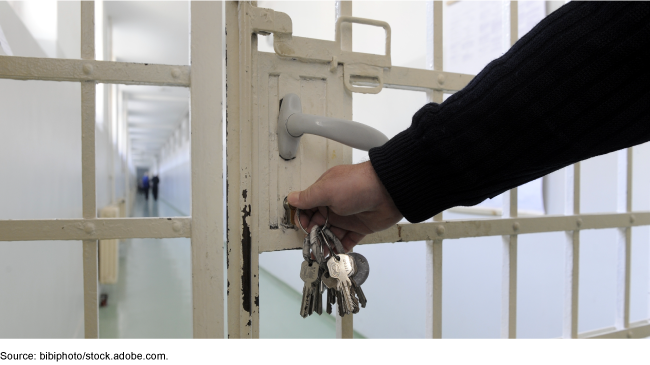Noncitizens in the U.S.: Public Information on Federal Incarcerations
Fast Facts
This Q&A report provides publicly available information on incarcerations of noncitizens in the U.S. while we continue ongoing work on related topics. For example:
Federal agencies don't collect citizenship information for all people in state and local facilities, where about 90% of incarcerated people are held
The number of noncitizens incarcerated by the Bureau of Prisons at the end of 2022 was 33% less than at the end of 2017
The number of noncitizens sentenced for federal crimes in FY 2023 was 27% less than in FY 2018
Of the noncitizens sentenced for federal crimes in FY 2018-2023, 76% were sentenced for immigration crimes

Highlights
What GAO Found
Components of the judicial branch, Department of Justice (DOJ), and Department of Homeland Security (DHS) collect or maintain information about the citizenship of individuals incarcerated by the Federal Bureau of Prisons (BOP). Federal agencies do not collect or maintain comprehensive information about the citizenship of individuals incarcerated in state prisons and local jails. According to a DOJ and DHS report about noncitizens incarcerated in the U.S., the lack of comprehensive information about state and local incarcerations was noteworthy because approximately 90 percent of individuals incarcerated in the U.S. are in state and local facilities.
According to Bureau of Justice Statistics (BJS) reports about incarcerations in the U.S., the number of noncitizens incarcerated by BOP decreased approximately 33 percent from year-end 2017 (36,000 noncitizens) compared to the number incarcerated at year-end 2022 (24,000 noncitizens) (see figure below). The latter part of this time period coincided with executive actions intended to decrease the number of individuals entering the U.S. and reduce the transmission of COVID-19, including an order that resulted in the immediate expulsion of certain noncitizens trying to enter the U.S.
Number of Noncitizens Incarcerated by the Federal Bureau of Prisons (BOP) at Year-End, 2017–2022

Note: For the purposes of this report, “incarcerated by BOP” refers to individuals under the jurisdiction of BOP, meaning they are under the legal authority of BOP, regardless of where they are held. The figure reflects information from Bureau of Justice Statistics (BJS) reports that use data from its National Prisoner Statistics effort. As part of that effort, BJS collects information annually from BOP about the individuals under the agency’s jurisdiction at year-end. Therefore, data reflect point-in-time information on individuals incarcerated and do not reflect the total number of individuals incarcerated during the year. The number of individuals under the jurisdiction of BOP includes individuals convicted and sentenced for an offense, as well as individuals who are held by BOP before their conviction and/or sentencing. The number of individuals under the jurisdiction of BOP also includes individuals sentenced for a felony in the District of Columbia.
The number of noncitizens sentenced for federal crimes varied from fiscal year 2018 through fiscal year 2023. However, compared to fiscal year 2018, the number of noncitizens sentenced for federal crimes in fiscal year 2023 decreased by 27 percent, from approximately 29,500 to 21,500 (see figure below).
Number of Noncitizens Sentenced for Federal Offenses, Fiscal Years 2018–2023

Note: Numbers include noncitizens sentenced in federal court for a felony or class A misdemeanor offense. Felonies are a sentencing classification of offenses which, under federal law, have a maximum term of imprisonment of at least more than 1 year. Class A misdemeanors are a sentencing classification of offenses which, under federal law, have a maximum term of imprisonment of at least 6 months and no more than 1 year. Numbers do not include noncitizens sentenced in federal court for a class B or class C misdemeanor offense. If an individual was sentenced for a felony or class A misdemeanor more than once in the same fiscal year, but in a separate case, each sentencing would be included in the fiscal year’s data, according to USSC officials. If an individual was sentenced for a felony or class A misdemeanor offense more than once and in different fiscal years, each sentencing would be included in the respective fiscal year’s data.
For approximately three-quarters of noncitizens sentenced for a federal crime from fiscal year 2018 through fiscal year 2023, the most serious offense they were convicted of—their “offense type”—was immigration-related (76 percent). Drug trafficking was the second most common offense type (14 percent).
Why GAO Did This Study
GAO was asked to provide an update to previous work and anticipates issuing the results of its analyses in late 2025. In the interim, this report provides information on the agencies that collect and maintain information about the citizenship of individuals incarcerated in the U.S., as well as publicly reported information on the number of noncitizens incarcerated by BOP at year-end for 2017 through 2022; the number of noncitizens sentenced for federal offenses from fiscal year 2018 through fiscal year 2023; and the type of offenses for which they were sentenced. Though related, this report has key definitional and methodological differences from past and ongoing work on noncitizens incarcerated in the U.S. As a result, information is not directly comparable.
To conduct this work, GAO reviewed documentation from DOJ and DHS and their component agencies, as well as from the U.S. Sentencing Commission (USSC), and interviewed officials. GAO analyzed publicly reported summary statistics from DOJ’s BJS and from USSC’s annual Sourcebook, which provides selected federal sentencing data. GAO selected the reporting time frames because methodological changes in BJS’s 2017 reported data and USSC’s fiscal year 2018 data meant they could not be compared to previous years. The end of the time frames corresponds to the most recent publicly reported data for each source as of August 2024.
For more information, contact Gretta Goodwin at (202) 512-8777 or GoodwinG@gao.gov.
